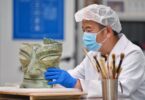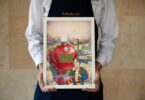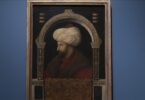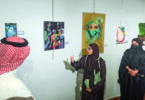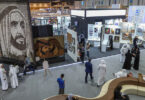Razmig Bedirian
NEW YORK : The warp and weft of Syrian history is being displayed at New York’s Katonah Museum of Art, in an exhibition that spans 2,000 years and highlights the area’s underappreciated but pivotal position in the global textile trade.
Running until January 28, Stories of Syria’s Textiles: Art and Heritage across Two Millennia is presenting works that date as far back as the first century, when Syria was a Roman province. In chronological order, it then exhibits textiles from Syria’s Ottoman and French Mandate periods before focusing on contemporary works while touching on how the war has put the country’s cultural heritage at risk.
:quality(70)/cloudfront-eu-central-1.images.arcpublishing.com/thenational/QH6JKDEQ3ZF3JBJLYPQY23XW5I.jpeg)
More than two dozen works have been loaned from museums and institutions, including the Metropolitan Museum of Art, Berkshire Museum and Yale University Art Gallery, alongside eight recently-produced textiles from Syria.
Stories of Syria’s Textiles is curated by Blair Fowlkes Childs, in collaboration with consultants Deniz Beyazit and Hany Hawasly. The exhibition, Fowlkes Child says, was inspired by her own expertise in the art and the archaeology of Syria in the Roman period, as well as the book Syrian Silk by Maya Alkateb-Chami.
“I was reading [the book] because I wanted to learn more about contemporary Syrian textiles as part of my research into Syrian cultural heritage,” Fowlkes Child says. “I learned a great deal. I was also connected to the viewpoint of the silk farmers and folk artisans she writes about and how they even connect their heritage to Palmyra.”
The ancient city, now situated in the centre of modern Syria, is one of two places where the exhibition begins telling the story of Syria’s textile history. The first section focuses on works originating in Palmyra as well as the ancient city of Dura-Europos, the ruins of which lie near the town of Al-Salihiyah on the western bank of the Euphrates River.
:quality(70)/cloudfront-eu-central-1.images.arcpublishing.com/thenational/DNQHMEXL7ZCGZJVAX2C2AK657M.jpeg)
From Dura-Europos comes a series of woven tapestry fragments that date from the early to mid-third century. Despite their tattered condition and age, the woollen fabrics remain breathtaking. One is olive-coloured, decorated with rosettes that bloom with gradients of beige and red. Others have floral and colourful bands or are decorated with deeply-dyed patterns.
They are juxtaposed with limestone reliefs and sculptures from Palmyra that give insights to how fabrics were worn during the time.
“Grouping the textiles and sculptures in the ancient section […] makes sense to learn about Dura-Europos and Palmyra, and the period we call the Late Anitiquity,” Fowlkes Childs says.
“The sculptures from Palmyra really make it possible to understand ancient clothing and styles. If you look at them closely you can see patterns carved into the textiles that are shown.
“I wanted to show people how we can understand tiny archeological textile fragments much better by looking at Palmyrian sculpture, and how we can understand Palmyrian sculpture much better if we look at the actual textile fragments.”
:quality(70)/cloudfront-eu-central-1.images.arcpublishing.com/thenational/JW4ASQL575FQ3PY4A5ID7VZ3FI.jpeg)
The textiles also are testament to Syria’s place in the western edge of the ancient Silk Routes, particularly with their use of Chinese silks.
Besides their decorative and clothing functions, textiles also had a protective aspect, Fowlkes Childs says. A number of pieces in the exhibition are testament to this, particularly a seventh-century tunic decoration with Alexander the hunter on horseback, and another fifth to sixth-century fragmentary band displaying scenes from Christ’s infancy.
“Both of these seem to be broadly protective for the person wearing them,” she says.
:quality(70)/cloudfront-eu-central-1.images.arcpublishing.com/thenational/FPWBELVEFRBBFON236ZODJS4RI.jpeg)
This protective element resonates into the second part of the exhibition, which focuses on the 19th and 20th century when Syria was under Ottoman rule before becoming a French Mandate.
The textiles also convey connotations of class and status. A woman’s clothing from northern Syria, decorated with lush patterns along the lapels and cuffs, and a festive dress from the Qalamoun region, embroidered with silk, are among examples of this. The pieces are on loan from the Museum of International Folk Art and the Philadelphia Museum of Art respectively.
Research and conservation efforts form a large part of the exhibition’s narrative. Several studies were carried out by colleagues of Fowlkes Childs to further understanding of how the textiles were made and their functions. Photo micrographs were taken to provide unprecedented detail of the threads and techniques used to make the textiles, while digital recreations of fragments exhibit the pieces in their full former glory.
:quality(70)/cloudfront-eu-central-1.images.arcpublishing.com/thenational/LMFLUNXFUVHZDMEZFQOVNYL3PU.jpeg)
“This helps us understand their history and cultural significance more specifically,” Fowlkes Childs says. “With the ancient ones, it helps us preserve them digitally. . Using these photo micrographs and creating digital reconstructions is ultimately a form of preservation because you’re dealing with fragile, organic archeological objects.”
The micrographs and the digital recreations, Fowlkes Childs adds, also document the strength of the textiles’ fibres, their condition and colour. The exhibition displays some of these photo micrographs alongside exhibited pieces “so that people can really understand what metal-wrapped thread is and how extraordinary that is”.
The exhibition’s third section is a poignant one. Containing several contemporary works, it underscores how since the conflict in Syria began in 2011, the country’s cultural heritage has been put at risk amid the humanitarian and refugee crisis. Archeological sites and museums have been destroyed and looted, incurring a dreadful loss of history and culture.
The third section, which is presented in a smaller gallery within the museum, also highlights Syria’s silk industry before the conflict.
“We’re using [the photographs] to illuminate the different people involved in producing textiles,” Fowlkes Childs says. “It’s really a show that focuses on the makers, the skilled weavers, artisans, dyers and embroiderers. It’s just not a focus on just the works and clothing, but on the actual process and people behind [the textiles].”
:quality(70)/cloudfront-eu-central-1.images.arcpublishing.com/thenational/2F5PYLVN2JDE3CGMXNANK74RAI.jpeg)
Many of the stories and studies that informed the exhibition are presented in its catalogue. This includes an essay by photojournalist and heritage researcher Rania Kataf.
“She is in Damascus, and she interviewed brocade and other textile producers,” Fowlkes Childs says.
The catalogue also draws from the research Alkateb-Chami and Hawasly carried out in the western mountains of Syria for the book Syrian Silk. “They were working with the people who are responsible for raising silkworms, and for what’s called reeling, producing the silk thread, and weaving.”
The catalogue, Fowlkes Childs says, is likely to be distributed internationally, making it accessible for those unable to attend the exhibition in person and making it a pivotal component to raising awareness on the cultural heritage of silk and textile production in Syria.
After all, that is one of the chief ambitions of the exhibition.
“As a scholar, I feel it is my job to disseminate research to make it available to the wider public, to encourage new research and conservation, and to also raise awareness of heritage more broadly,” Fowlkes Childs says.
Courtesy: thenationalnews


